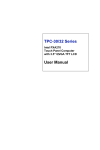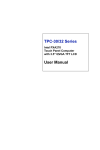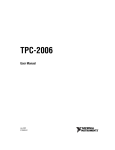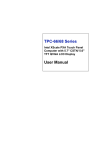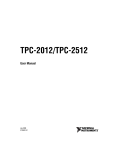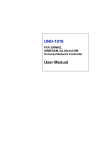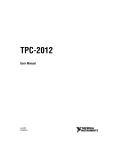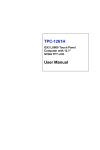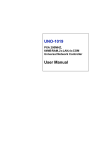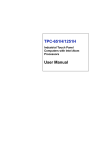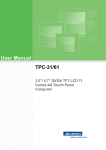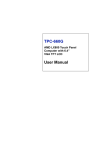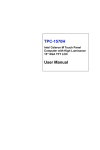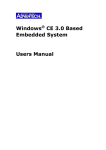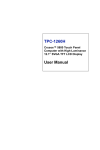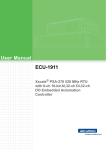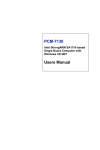Download TPC-60S User Manual
Transcript
TPC-60S
ARM9 Touch Panel Computer
with 5.7” QVGA STN LCD Display
User Manual
Copyright
The documentation and the software included with this product are copyrighted 2004 by Advantech Co., Ltd. All rights are reserved. Advantech
Co., Ltd. reserves the right to make improvements in the products
described in this manual at any time without notice. No part of this manual may be reproduced, copied, translated or transmitted in any form or
by any means without the prior written permission of Advantech Co., Ltd.
Information provided in this manual is intended to be accurate and reliable. However, Advantech Co., Ltd. assumes no responsibility for its use,
nor for any infringements of the rights of third parties, which may result
from its use.
Acknowledgements
IBM, PC/AT, PS/2 and VGA are trademarks of International Business
Machines Corporation.
Microsoft Windows and MS-DOS are registered trademarks of
Microsoft Corp.
All other product names or trademarks are properties of their respective
owners.
Part No. 2003006002
3rd Edition
Printed in Taiwan
July 2005
TPC-60S User Manual
ii
Product Warranty (1 year)
Advantech warrants to you, the original purchaser, that each of its products will be free from defects in materials and workmanship for one year
from the date of purchase.
This warranty does not apply to any products which have been repaired or
altered by persons other than repair personnel authorized by Advantech,
or which have been subject to misuse, abuse, accident or improper installation. Advantech assumes no liability under the terms of this warranty as
a consequence of such events.
Because of Advantech’s high quality-control standards and rigorous testing, most of our customers never need to use our repair service. If an
Advantech product is defective, it will be repaired or replaced at no
charge during the warranty period. For out-of-warranty repairs, you will
be billed according to the cost of replacement materials, service time and
freight. Please consult your dealer for more details.
If you think you have a defective product, follow these steps:
1.
Collect all the information about the problem encountered. (For
example, CPU speed, Advantech products used, other hardware
and software used, etc.) Note anything abnormal and list any
onscreen messages you get when the problem occurs.
2.
Call your dealer and describe the problem. Please have your manual, product, and any helpful information readily available.
3.
If your product is diagnosed as defective, obtain an RMA (return
merchandize authorization) number from your dealer. This allows
us to process your return more quickly.
4.
Carefully pack the defective product, a fully-completed Repair and
Replacement Order Card and a photocopy proof of purchase date
(such as your sales receipt) in a shippable container. A product
returned without proof of the purchase date is not eligible for warranty service.
5.
Write the RMA number visibly on the outside of the package and
ship it prepaid to your dealer.
iii
CE
This product has passed the CE test for environmental specifications.
FCC Class A
This equipment has been tested and found to comply with the limits for a
Class A digital device, pursuant to Part 15 of the FCC Rules. These limits
are designed to provide reasonable protection against harmful interference when the equipment is operated in a commercial environment. This
equipment generates, uses and can radiate radio frequency energy and, if
not installed and used in accordance with the instruction manual, may
cause harmful interference to radio communications. Operation of this
equipment in a residential area is likely to cause harmful interference in
which case the user will be required to correct the interference at his own
expense.
Safety Instructions
1.
Read these safety instructions carefully.
2.
Keep this User's Manual for later reference.
3.
Disconnect this equipment from any AC outlet before cleaning.
Use a damp cloth. Do not use liquid or spray detergents for cleaning.
4.
For plug-in equipment, the power outlet socket must be located
near the equipment and must be easily accessible.
5.
Put this equipment on a reliable surface during installation. Dropping it or letting it fall may cause damage.
6.
The openings on the enclosure are for air convection. Protect the
equipment from overheating. DO NOT COVER THE OPENINGS.
7.
Make sure the voltage of the power source is correct before connecting the equipment to the power outlet.
8.
Position the power cord so that people cannot step on it. Do not
place anything over the power cord.
9.
All cautions and warnings on the equipment should be noted.
10.
If the equipment is not used for a long time, disconnect it from the
power source to avoid damage by transient overvoltage.
11.
Never pour any liquid into an opening. This may cause fire or electrical shock.
TPC-60S User Manual
iv
12.
Never open the equipment. For safety reasons, the equipment
should be opened only by qualified service personnel.
13.
If one of the following situations arises, get the equipment checked
by service personnel:
a. The power cord or plug is damaged.
b. Liquid has penetrated into the equipment.
c. The equipment has been exposed to moisture.
d. The equipment does not work well, or you cannot get it to work
according to the user's manual.
e. The equipment has been dropped and damaged.
f. The equipment has obvious signs of breakage.
14.
Do not leave this equipment in an environment where the storage
temperature may go below -20° C (-4 °F) or above 70° C (158° F).
This could damage the equipment.
15.
If one of the following situations arises, get the equipment checked
by service personnel:
a.
The Power cord or plug is damaged.
b.
Liquid has penetrated into the equipment.
c.
The equipment has been exposed to moisture.
d.
The equipment has not work well or you can not get it work
according to user‘s manual.
e.
The equipment has dropped and damaged.
f.
If the equipment has obvious sign of breakage
16.
Never open the equipment. For safety reasons, only quali fied service personnel should open the equipment.
17.
CAUTION: The computer is provided with a battery-powered realtime clock circuit. There is a danger of explosion if battery is incorrectly replaced. Replace only with same or equivalent type recommended by the manufacture. Discard used batteries according to the
manufacturer’s instructions.
v
Wichtige Sicherheishinweise
1.
Bitte lesen sie Sich diese Hinweise sorgfältig durch.
2.
Heben Sie diese Anleitung für den späteren Gebrauch auf.
3.
Vor jedem Reinigen ist das Gerät vom Stromnetz zu trennen. Verwenden Sie Keine Flüssig-oder Aerosolreiniger. Am besten dient
ein angefeuchtetes Tuch zur Reinigung.
4.
Die NetzanschluBsteckdose soll nahe dem Gerät angebracht und
leicht zugänglich sein.
5.
Das Gerät ist vor Feuchtigkeit zu schützen.
6.
Bei der Aufstellung des Gerätes ist auf sicheren Stand zu achten.
Ein Kippen oder Fallen könnte Verletzungen hervorrufen.
7.
Die Belüftungsöffnungen dienen zur Luftzirkulation die das Gerät
vor überhitzung schützt. Sorgen Sie dafür, daB diese Öffnungen
nicht abgedeckt werden.
8.
Beachten Sie beim. AnschluB an das Stromnetz die AnschluBwerte.
9.
Verlegen Sie die NetzanschluBleitung so, daB niemand darüber
fallen kann.
10.
Es sollte auch nichts auf der Leitung abgestellt werden. Alle Hinweise und Warnungen die sich am Geräten befinden sind zu
beachten.
11.
Wird das Gerät über einen längeren Zeitraum nicht benutzt, sollten
Sie es vom Stromnetz trennen. Somit wird im Falle einer Überspannung eine Beschädigung vermieden.
12.
Durch die Lüftungsöffnungen dürfen niemals Gegenstände oder
Flüssigkeiten in das Gerät gelangen. Dies könnte einen Brand bzw.
elektrischen Schlag auslösen.
13.
Öffnen Sie niemals das Gerät. Das Gerät darf aus Gründen der elektrischen Sicherheit nur von authorisiertem Servicepersonal geöffnet werden.
14.
Wenn folgende Situationen auftreten ist das Gerät vom Stromnetz
zu trennen und von einer qualifizierten Servicestelle zu überprüfen:
a - Netzkabel oder Netzstecker sind beschädigt.
b - Flüssigkeit ist in das Gerät eingedrungen.
c - Das Gerät war Feuchtigkeit ausgesetzt.
d - Wenn das Gerät nicht der Bedienungsanleitung entsprechend
funktioniert oder Sie mit Hilfe dieser Anleitung keine Verbesse
TPC-60S User Manual
vi
Technical Support and Assistance
Step 1. Visit the Advantech web site at www.advantech.com/support
where you can find the latest information about the product.
Step 2. Contact your distributor, sales representative, or Advantech's customer service center for technical support if you need additional
assistance. Please have the following information ready before
you call:
- Product name and serial number
- Description of your peripheral attachments
- Description of your software (operating system, version, application software, etc.)
- A complete description of the problem
- The exact wording of any error messages
Packing List
Before setting up the system, check that the items listed below are
included and in good condition. If any item does not accord with the
table, please contact your dealer immediately.
• 1 x TPC-60S
• 6 x Panel mounting clamper
• 6 x Panel mounting screw
• 1 x 3-Pin power connector
• 1 x TPC-60S support CD
• 1 x 9-pin to 9-pin null modem cable
• 1 x Microsoft Windows CE end user license agreement *
• 1 x 1.8 meter USB client - USB host cable
• 1 x 6 cm single DB-9 to dual DB-9 serial ports shunting cable
* Only available in the model bundled with Windows CE OS.
vii
TPC-60S User Manual
viii
Contents
Chapter
Chapter
1 General Information ....................................... 2
1.1
1.2
Introduction ....................................................................... 2
Specifications .................................................................... 2
1.3
1.4
1.5
1.6
LCD Specifications ........................................................... 4
Touchscreen Specifications............................................... 4
Power................................................................................. 5
I/O Ports Arrangement ...................................................... 5
1.7
Panel Mounting ................................................................. 6
1.8
Exploded Diagram............................................................. 7
1.9
Dimensions and Cutout ..................................................... 8
1.2.1
1.2.2
1.2.3
1.2.4
System Kernel ................................................................ 2
I/O Ports ......................................................................... 3
Storage ........................................................................... 3
Safety and Environment ................................................. 3
Figure 1.1:I/O Ports Arrangement ................................. 5
Figure 1.2:Panel Mounting ............................................ 6
Figure 1.3:Assembly Exploded ..................................... 7
Figure 1.4:Dimensions and Cutout ................................ 8
2 System Setup.................................................. 10
Figure 2.1:Unpack the Package ................................... 10
Figure 2.2:Power Connector and Power Lines ............ 10
Figure 2.3:Pin Assignment on the Power Receptor ..... 11
Figure 2.4:Plug Power Line to System Pwr Receptor . 11
Figure 2.5:Turn on the System .................................... 12
Chapter
Chapter
3 System Tuning ............................................... 14
3.1
LCD Contrast Tuning...................................................... 14
3.2
Touchscreen Calibration ................................................. 15
3.3
Buzzer Setting ................................................................. 17
Figure 3.1:Display ....................................................... 14
Figure 3.2:Display Properties ...................................... 14
Figure 3.3:Advanced Backlight Utility ........................ 15
Figure 3.4:Style ............................................................ 15
Figure 3.5:Stylus Properties ......................................... 16
Figure 3.6:Touch Screen Calibration ........................... 16
Figure 3.7:Volume & Sounds Settting 1 ...................... 17
Figure 3.8:Volume & Sounds Settting 2 ...................... 17
Figure 3.9:Buzzer Setting 1 ......................................... 18
Figure 3.10:Buzzer Setting 2 ....................................... 18
4 Windows CE .NET 4.2 ................................. 20
Figure 4.1:Windows CE on TPC-60S .......................... 20
4.1
TPC Utilities.................................................................... 21
4.1.1
Soft-Keyboard .............................................................. 21
ix
4.1.2
4.1.3
4.1.4
4.2
Networking...................................................................... 34
4.2.1
4.2.2
4.2.3
4.3
Figure 4.2:Soft-Keyboard ............................................ 21
TPC Configuration ....................................................... 21
Figure 4.3:TPC Configurator ....................................... 22
Figure 4.4:General ....................................................... 22
Figure 4.5:Network ...................................................... 23
Figure 4.6:Advanced Network ..................................... 23
Figure 4.7:WatchDog Setting ...................................... 24
Figure 4.8:Misc Page ................................................... 25
Figure 4.9:Reboot Machine ......................................... 26
Figure 4.10:Registry Saving Success ........................... 27
Figure 4.11:Registry Editor ......................................... 27
Advantech Tools .......................................................... 28
Figure 4.12:Advantech Tools ...................................... 28
Figure 4.13:Remote Display Host Application ............ 29
Figure 4.14:Remote Display Application .................... 30
Figure 4.15:Connect .................................................... 30
Figure 4.16:Remote Display Host Application with the
display of TPC-60S .......................................... 31
Figure 4.17: TPC CE Notepad ..................................... 31
Figure 4.18:TPC Version Information ......................... 32
Other Utilities .............................................................. 33
Network via Ethernet ................................................... 34
Figure 4.19:Network and Dial-up Connections ........... 34
Figure 4.20:Selected Connection ................................. 35
Figure 4.21:Setting IP Address .................................... 35
Figure 4.22:Setting Name Servers ............................... 36
Figure 4.23:Save Registry ............................................ 36
Network via Serial Port ................................................ 37
Figure 4.24:PC Connection .......................................... 37
Figure 4.25:PC Connection Properties ........................ 38
Figure 4.26:Change Connection .................................. 38
Figure 4.27:Change Connection .................................. 39
Figure 4.28:COM1 Set ................................................. 39
Figure 4.29:Microsoft ActiveSync .............................. 40
Figure 4.30:Select Connection Setting ........................ 40
Figure 4.31:Configure Connection Setting .................. 41
Figure 4.32:Get Connected .......................................... 42
Figure 4.33:Run Repllog.exe on the TPC .................... 42
Figure 4.34:Connection on the TPC ............................ 43
Figure 4.35:Connection on the Host PC ...................... 43
Figure 4.36:Explore the TPC ....................................... 44
Network via USB Client Port ...................................... 44
Application Program Development................................. 45
4.3.1
4.3.2
TPC-60S User Manual
System Requirements for Developers .......................... 45
Building Windows CE .NET Runtime ........................ 46
x
Figure 4.37:Starting a New Project .............................. 47
Figure 4.38:Selecting ................................................... 47
Figure 4.39:Compiling Your Program ......................... 48
Appendix A Watchdog Timer Programming................... 50
A.1
A.2
A.3
DeviceIOControl ............................................................. 50
How to Use the Control Code ......................................... 52
A.2.1
A.2.2
A.2.3
A.2.4
A.2.5
A.2.6
IOCTL _WDT_ENABLE: ........................................... 52
IOCTL _WDT_DISABLE: .......................................... 52
IOCTL_WDT_STROBE: ............................................ 52
IOCTL_WDT_GETTIMEOUT: .................................. 53
IOCTL_WDT_SETTIMEOUT: .................................. 53
IOCTL_WDT_REBOOT: ........................................... 53
Examples ......................................................................... 54
Appendix B Fuse Specifications ........................................ 58
B.1
B.2
Fuse Specifications.......................................................... 58
Fuse Replacement ........................................................... 58
Figure B.1:Fuse Replacement ...................................... 58
Appendix C Pin Assignments ............................................ 60
C.1
C.2
C.3
RS-232 Pin Assignment .................................................. 60
RS-485 Pin Assignment .................................................. 60
COM Port Setting............................................................ 60
xi
TPC-60S User Manual
xii
CHAPTER
1
2
General Information
This chapter gives background information for the TPC-60S.
Sections include:
• Introduction
• Specifications
• LCD Specifications
• Touchscreen Specifications
• Power
• I/O Port Arrangement
• Mounting
• Exploded Diagram
• Dimensions and Cutout
Chapter 1 General Information
1.1 Introduction
The TPC-60 touch panel computer is a state-of-the-art HMI (Human
Machine Interface). This 5.7” display operator interface is a RISC-based
platform with these key features:
• Bright Display:
The high brightness CSTN LCD display provides a clear interface.
• Fanless:
By using a low power processor, the system does not have to rely on
fans, which often are unreliable, and attracts dust.
• Powerful Communication Capability:
The TPC-60 provides a powerful I/O interface for easy communication
with other devices. The I/O interface includes serial ports, RS-485
port, Ethernet and USB.
• Windows CE Support:
Advantech offers platform support for Windows CE. The optional
Windows CE operating system specifically for the TPC-60 is available
for Windows CE application program builders.
• JVM Support:
TPC-60 is powered by JVM that is compatible with PersonalJava 1.2.
1.2 Specifications
1.2.1 System Kernel
• CPU: Samsung S3C2410A-26 (CPU clock 266 MHz)
• BIOS: Samsung NAND Flash memory
• VGA: Samsung S3C2410A-26 Integrated
• DRAM: Built-in 64MB SDRAM
• Storage Memory: Built-in Samsung 64 MB NAND Flash
• Ethernet: DM9000E 10/100Base-T Ethernet controller; IEEE 802.3u
protocol compatible
• Watchdog Timer: Samsung S3C2410A watchdog timer;
2,5,10,15,30,40 second timeout period option
• CompactFlash: CompactFlash type I/II
TPC-60S User Manual
2
1.2.2 I/O Ports
• 3 serial ports: two RS-232 (COM1, COM2); one RS-485 (COM4) or
one RS-232(COM3)
Note
TPS-60S provides three serial ports. The third
one can be set as COM3 for RS-232 or COM4 for
RS-485.
Note:
It is suggested to use hardware flow control in
order to avoid data loss.
• 1 RJ-45 Ethernet port
• 2 USB ports compliant with USB 1.1: one USB Host (Type A) and one
USB Client (Type B)
• 1 CompactFlash 2.0 type I/II slot
1.2.3 Storage
TPC-60S provides two methods for storage. One is the on-board 64 MB
NAND flash and the other one is a CompactFlash card. The system bootsequence is:
• If there is no CompactFlash card installed, the system will automatically boot from the on-board NAND Flash.
• CompactFlash card only: the system will boot from CompactFlash card
1.2.4 Safety and Environment
Safety
• FCC Class A, CE and BSMI certified
• The front bezel is compliant with NEMA 4
Environment
• Operating Temperature: 0~50° C
• Storage Temperature: -20~70° C
• Humidity: 10~95% @ 40° C relative humidity (non-condensing)
• Vibration:
10~18 Hz @ 1.5mm peak-to-peak displacement
18~500 Hz @ 1G acceleration
3
Chapter 1
1.3 LCD Specifications
Display Type
Color STN LCD
Size (diagonal)
5.7”
Maximum Resolution
320 x 240 (QVGA)
Maximum Colors
256
Pixel Pitch (W x H, mm)
0.12 x 0.36
Viewing Angle
110°
Luminance (cd / m2)
201
Contrast Ratio
35
Operating Temperature (¢J)
0 ~ 50 (Ambient)
Control
Contrast Adjustable
Backlight
1 CCFL
LCD MTBF
100,000 hours
Backlight MTBF
40,000 hours
1.4 Touchscreen Specifications
Touch Type
Resistive
Base Glass Construction
Tempered Glass
Resolution
Continuous
Light Transmission
75% typical
Controller
SPI (AD7846)
Power Rating
5 VDC
Software Driver
Windows CE (embedded)
Durability
100 million touches
Note
There is no pointer/cursor shown using the
touch screen. The cursor only appears when
closing or minimizing the window.
TPC-60S User Manual
4
1.5 Power
• Input Voltage: 24 VDC (the fuse will become an open circuit if input
level exceeds 33 VDC)
• Maximum Current: 2 A
1.6 I/O Ports Arrangement
The TPC-60S provides the 3 serials ports, 1 Ethernet LAN port and 2
USB ports. The arrangement of the I/O ports is shown in Figure 1.1.
Figure 1.1: I/O Ports Arrangement
5
Chapter 1
1.7 Panel Mounting
There is an adhesive waterproof gasket on the A-Mg front bezel. Make
sure the waterproof gasket is in position before installing the TPC-60 into
the panel opening.
1.
Install the TPC-60 to the panel opening.
2.
Find the eight clampers and eight long screws in the accessory
pack. Hook these clampers to the holes around the four sides of the
bezel. Insert the screws into every clamper and fasten them. These
screws will then push the mounting panel and fix the unit. The
mounting panel thickness is suggested to be less than 6 mm (0.236
inch).
Figure 1.2: Panel Mounting
TPC-60S User Manual
6
1.8 Exploded Diagram
Figure 1.3: Assembly Exploded
7
Chapter 1
1.9 Dimensions and Cutout
• Weight: 0.8 Kg
• Dimensions (WxHxD): 195 x 148 x 44.5 mm
• Cutout: 188 x 141 mm (suggested)
Figure 1.4: Dimensions and Cutout
TPC-60S User Manual
8
CHAPTER
2
2
System Setup
This chapter provides a brief explanation for operating the TPC-60S.
Chapter 2 System Setup
You can quickly get up and running by following the step-by-step
instructions below.
1.
Unpack the TPC-60 package. Please check the packing list at the
beginning of this manual to make sure every item is there.
Figure 2.1: Unpack the Package
2.
Connect the power connector to the 24 VDC power lines. The
power lines can either be from some power adapter or an in-house
power source.
Figure 2.2: Power Connector and Power Lines
TPC-60S User Manual
10
Figure 2.3: Pin Assignment on the Power Receptor
Warning
3.
The system may be damaged when the power
is turned on if the power source is not connected to the correct pins.
Plug the power lines into the system power receptor.
Figure 2.4: Plug the Power Line to the System Power Receptor
11
Chapter 2
4.
Turn on the System
Figure 2.5: Turn on the System
5.
Calibrate the touchscreen. The detailed procedure is described in
section 3.2.
TPC-60S User Manual
12
CHAPTER
3
2
System Tuning
Sections include:
• LCD Contrast Tuning
• Touchscreen Calibration
• Buzzer Setting
Chapter 3 System Tuning
3.1 LCD Contrast Tuning
The display settings let you control the backlight. Backlight provides a screen saving function. The backlight can be automatically
turned off when the device is no longer used to lengthen the device
life. Please go to “Start” ! “Setting” ! “Control Panel” ! “Display”
as shown in the Figure below.
Figure 3.1: Display
To set the time to automatically turn off, tick the check box ‘turn off
backlight’ and set the time to elapse by inputting a number in the edit
box.
Figure 3.2: Display Properties
TPC-60S User Manual
14
Click the “Advanced” button to activate the advanced backlight utility as
shown in Figure 3.3. Click the “+” button to increase the LCD brightness
or contrast, or the “-” button to decrease the LCD brightness or contrast.
You can also click the slider, hold it, and move it to the designed value
and then release the button.
Figure 3.3: Advanced Backlight Utility
3.2 Touchscreen Calibration
You can calibrate the touch screen through “Start” ! “Setting” !
“Control Panel” ! “Stylus” as shown in the Figure below.
Figure 3.4: Style
15
Chapter 3
The window of the stylus properties will display after you click the stylus.
There are two tabs in this screen: Double-Tap and Calibration. DoubleTap is used to record the time period between the two taps when doubletapping in Windows CE. Calibration is for users to calibrate the touch
screen.
Figure 3.5: Stylus Properties
Please press “Calibration” and then click “Recalibrate” to calibrate the
touch screen as shown below. A cross will appear on the screen in the
order: center point, upper-left, lower-left, lower-right, and upper-right.
Use the stylus to tap the center of the cross until the cross moves to next
location.
Figure 3.6: Touch Screen Calibration
TPC-60S User Manual
16
3.3 Buzzer Setting
TPC-60S provides a buzzer setting in Windows CE .NET 4.2. This
function enables TPC-60S to beep when users use the touch
screen. To enable/disable this functionality, open “Start” ! “Setting” ! “Control Panel” ! “Volume & Sounds” as shown in Figure
3.7.
Figure 3.7: Volume & Sounds Settting 1
As shown in Figure 3.8, you can enable/disable this functionality or set
the frequency.
Figure 3.8: Volume & Sounds Settting 2
17
Chapter 3
Users can change the frequency of sounds by opening "Start"->"Setting">"Control Panel"-> "Buzzer Setting" as shown in the figure 3.9.
Figure 3.9: Buzzer Setting 1
Set the frequency of sounds as shown in Figure 3.10.
Figure 3.10: Buzzer Setting 2
TPC-60S User Manual
18
CHAPTER
4
2
Windows CE .NET 4.2
Sections include:
• TPC Utilities
• Networking
• Application Program Development
Chapter 4 Windows CE .NET 4.2
The TPC-60S operator interface terminal is designed for Windows CE.
Windows CE is a compact operating system that occupies less storage
space and use less system resources compared with other operating systems. By its modular nature, it is possible to choose the functions that are
useful for a specific application. This not only reduced the system
resources required, it also reduces start-up time. In the field of industrial
automation or for operator interface terminals, this is an appealing feature
because the impact of downtime is minimized. Furthermore, the small
storage space required makes it possible to install the operating system on
a reliable solid-state disk.
Note
The default version of Windows CE in TPC-60S
is the English version. Please contact your local
Advantech representative for local language
support.
Figure 4.1: Windows CE on TPC-60S
Note:
TPC-60S also provides Remote Desktop Connection in Windows CE but the maximum resolution supported is only 320 x 240.
TPC-60S User Manual
20
4.1 TPC Utilities
There are several utilities built into Windows CE .NET in the TPC series.
4.1.1 Soft-Keyboard
The TPC-60 is dedicated to small-sized operator interfaces. Since it is not
convenient to attach a keyboard to such a small device, a software
keyboard is built into the standard TPC-60 Windows CE .NET OS. Upon
boot-up, a small keyboard icon will appear on the status bar. Tap this icon
with the stylus to activate/hide this Soft-keyboard.
Figure 4.2: Soft-Keyboard
4.1.2 TPC Configuration
The TPC-60 provides an integrated utility to configure the basic settings
of the device. Execute it by clicking the TPC Configurator icon on the
desktop. Navigate the configuration by tapping the four tab pages for:
general, network, watchdog and misc.
21
Chapter 4
Figure 4.3: TPC Configurator
General Page
This page displays the basic system information. There are two main
parts: system and memory. The system shows the OS image version and
CPU type. The second part includes total capacity, usage and currently
available capacity of the disk and the memory.
Figure 4.4: General
TPC-60S User Manual
22
Network
This page shows information about the active network adapter. You can
select the network adapter from the combo box as shown in Figure 4.5.
Release the current IP and retrieve the new IP through the provided button, “Renew”.
Use the “Ping” button to ping a specified IP address if you wish to test the
connection.
Figure 4.5: Network
You can get more detailed IP information through “Advanced Network”.
The information contains the default gateway, DHCP server, WINS and
DNS server address as shown in Figure 4.6 below.
Figure 4.6: Advanced Network
23
Chapter 4
WatchDog
Watchdog is a function to let the device automatically reset if a program
does not respond in time. This prevents system crashes and hangs to stop
your critical applications, as the watchdog will automatically restart the
machine when required.
Set the response time through the combo box as shown below. The timer
is the period that the watchdog will wait for a response.
Figure 4.7: WatchDog Setting
Only when you select a time span and enable the watchdog, will the
response time be effective. When the watchdog is enabled and the "Test"
button is clicked, the NO resetting signal will be periodically sent to the
watchdog hardware on board. The watchdog will suppose the machine to
be deadlocked and REBOOT it after the watchdog response time. If the
machine reboots as expected after the watchdog response time, the watchdog is proved to be working properly.
TPC-60S User Manual
24
Misc
There are several functions provided in the Misc page as shown in the figure below.
Figure 4.8: Misc Page
CompactFlash Disk Folder Name: There is a pull-down menu to set the
folder name of the CompactFlash memory card. The default folder name
is “Storage Card”.
Warning
Do NOT try to key in the folder name in the text
box directly. If the CompactFlash folder is
renamed to some name that is beyond the
given list, there will be irreversible problems for
users’ application program settings.
Startup Programs: You can easily set the startup programs without editing. The programs listed in the combo box will be automatically executed
after the system has successfully booted. Click the “Add” button to insert
a file to the startup. If you would like to remove the file from the startup
or the combo box, please click “Delete”.
Note
Do NOT try to insert a NON-executable file into
the startup program.
25
Chapter 4
Reboot: You can reboot TPC-60S by clicking the “Reboot” button. Once
this button is clicked, the dialog below will be displayed.
Figure 4.9: Reboot Machine
There are two additional ways to reboot the system, clicking a small
machine icon on the status bar and executing a command, reboot.exe,
through a command line program.
TPC-60S User Manual
26
Registry: You can click the “Save” button to save the registry to a solid
state disk, and click the “View” button to view, edit, create, or delete registry information. You also can backup or restore the registry setting by
clicking the backup or restore button.
Note
It is not allowed to backup and restore over
different image versions.
Figure 4.10: Registry Saving Success
Figure 4.11: Registry Editor
27
Chapter 4
Web Server Root: Input the root path of the web server here. The root
path will only be effective after the machine has been rebooted.
FTP Server Root: Input the root path of the ftp server here. The root path
will only be effective after the machine has been rebooted.
4.1.3 Advantech Tools
There are several useful tools in the Advantech program. Please
go to “Start” ! “Programs” ! “Advantech” to run the tools as
shown in Figure 4.12. The tools include “ActiveSync”, “Registry
Editor”, “Registry Saver”, “Remote Display Application”, “TPC CE
Notepad”, “TPC Configurator” and “TPC Version Information”.
Figure 4.12: Advantech Tools
ActiveSync
This program synchronizes data and monitors the connection between
TPC-60S and the host computer. By default, it will be executed automatically when you want to establish a connection to a target device with
ActiveSync.
TPC-60S User Manual
28
Registry Editor
When Registry Editor is executed as shown in the Figure 4.11, you can
use this program to view, edit, enter, delete or save registry data.
Registry Saver
When Registry Saver is executed, the system registry will be saved. Also,
you can execute it in a command-line environment to save the registry
like “regsave.exe” or “regsave.exe –s” for the silence mode.
Remote Display Application
Remote Display Application displays a Windows CE device screen on a
remote desktop. It works with the Windows CE Remote Display Host
application. Because the connection is through the network, the network
function of the host machine and TPC-60S must work properly. Via the
Remote Display Application you can see the display of TPC-60S and
control TPC-60S from a host machine.
Remote Display Host application (cerhost.exe) must be executed on a
remote host desktop as shown in the Figure 4.13.
Figure 4.13: Remote Display Host Application
29
Chapter 4
In addition, you must run Remote Display Application on TPC-60S as
shown in the Figure 4.14. Click the “Connect” button and key in the host
name or IP address as shown in the Figure 4.15.
Figure 4.14: Remote Display Application
Figure 4.15: Connect
TPC-60S User Manual
30
Once the connection is successfully established, you can see the display
of TPC-60S and control it from the host machine as shown in Figure 4.16.
Figure 4.16: Remote Display Host Application with the display of TPC-60S
TPC CE Notepad
TPC CE Notepad is a text editor as shown in Figure 4.17.
Figure 4.17: TPC CE Notepad
31
Chapter 4
TPC Configurator
TPC Configurator is an integrated utility to configure the basic settings of
TPC-60S. Please refer to section 4.1.2.
TPC Version Information
TPC Version Information shows the version information of the operation
system in the TPC-60S as shown in Figure 4.18.
Figure 4.18: TPC Version Information
TPC-60S User Manual
32
4.1.4 Other Utilities
There are other utilities provided in TPC-60S. These utilities are command-line executed programs that do not have a graphical user interface.
Please type the command names shown below in the command-line.
Bright.exe [Level]:
Sets the brightness level of the display. The parameter is from 1 to 10.
Buzzer.exe [frequency] [duration]:
Plays a beep. Use parameters to decide the frequency (Unit: Hz) and
duration (Unit: ms). If you don’t use any parameters, the default frequency is 350 Hz and default duration is 30 ms.
Contrast.exe [Level]:
Sets the contrast of the display. The parameter is from 1 to 10.
RegSave.exe [-s]:
Saves registry settings. If you use “RegSave.exe –s”, no message box is
displayed whether you are successful or fail.
Reboot.exe:
Saves the registry settings and reboots TPC-60S.
Screen.exe [on/off]:
Turns the display on/off. Use “Screen.exe on” to turn on and “Screen.exe
off” to turn off the display.
Iesample.exe [-n] [-f] [ip address/ folder name]:
Open the Internet Explorer. Use "Iesample.exe -n" to close the scroll bar.
Use "Iesamples.exe -f" to active the full screen. The three parameters can
be blank.
33
Chapter 4
4.2 Networking
4.2.1 Network via Ethernet
This section shows how to configure the Ethernet port of the TPC
series properly. The procedure is listed below step by step.
Note
Please make sure you are connected to a LAN
before the system boots up.
Note
The buffer size of the data transfer per package through Ethernet is around 20000.
1.
Press Start in the task bar of Windows and select “Setting” -> “Networking and Dial-up connections”.
Figure 4.19: Network and Dial-up Connections
TPC-60S User Manual
34
2.
A window that shows all available connections will pop up. Double
click the icon that has the connection you want to configure. For
example, double click DM9CE1 icon to configure.
Figure 4.20: Selected Connection
3.
Select the “IP Address” tab.
Figure 4.21: Setting IP Address
35
Chapter 4
4.
Select the “Name Server” tab.
Figure 4.22: Setting Name Servers
Note
5.
Do NOT click the Next button at this time.
Press “Start” in of task bar of Windows and select “Run”. Execute
“regsave” to save the registry settings to a storage card.
Figure 4.23: Save Registry
TPC-60S User Manual
36
4.2.2 Network via Serial Port
This section introduces how to setup the connection between the TPC
series and a host PC via Microsoft ActiveSync.
ActiveSync Setting Procedure
Insert the TPC CD into the CD-ROM of the host PC
Install the TPC software development kit for eVC++.
Install Microsoft ActiveSync.
Connect the host computer and TPC with a null modem cable (included
in the package). Make sure the connection is solid on both RS-232 Serial
ports.
Setup the communication environment of the TPC and the host
Setup the Communication Environment of TPC
Configure COM1 on the TPC. Press “Start” in Windows and select “Setting”-> “Control Panel”
Click the icon “PC Connection”
Figure 4.24: PC Connection
37
Chapter 4
Click 'change...' to select the COM port- serial 1 or serial 2. In this
example, we use COM1 of TPC to connect with COM1 of the host..
Figure 4.25: PC Connection Properties
Please check the combox and select your desired COM port from the list.
Figure 4.26: Change Connection
TPC-60S User Manual
38
Press the 'enter' symbol from the keyboard to confirm the change.
Figure 4.27: Change Connection
You can find the change is active. The connection is via serial1 - COM1.
Figure 4.28: COM1 Set
39
Chapter 4
Setting the Communication Environment of the Host
Double click the icon ActiveSync on your host computer.
Figure 4.29: Microsoft ActiveSync
Select “File”->”Connection Settings”
Figure 4.30: Select Connection Setting
TPC-60S User Manual
40
Configure the connection setting.
Figure 4.31: Configure Connection Setting
41
Chapter 4
A window will pop up after you press “Get Connected”.
Figure 4.32: Get Connected
Please run “repllog.exe” on the TPC.
Figure 4.33: Run Repllog.exe on the TPC
Press the “Next” button on your host computer.
TPC-60S User Manual
42
The message shown below will show on the TPC once the TPC and the
host PC are connected.
Figure 4.34: Connection on the TPC
A window will pop up as shown below on the host computer, once the
TPC and the host PC are connected. Select “No” and then press “Next”.
Figure 4.35: Connection on the Host PC
Select “Explore” in the Microsoft ActiveSync window, the window,
Mobile Device, will pop up to display the file resources and information
of TPC. For example, you could click the icon “My documents” to see the
content of storage in TPC.
43
Chapter 4
Figure 4.36: Explore the TPC
4.2.3 Network via USB Client Port
In addition to connecting via a null modem cable as depicted in section
4.2.3, TPC-60S can also be connected to the host computer via the client’s USB port. The host computer must install the Microsoft ActiveSync
service offered by Microsoft. Then use the USB client to USB host cable
and connect the USB client port of the TPC-60S and the USB host port of
the host computer. Be sure that the PC connection setting of TPC-60S is
“USB Socket Default” as shown in the Figure 4.27. This is also the
default setting of TPC-60S. Then the above steps will make TPC-60S try
to connect the host automatically.
TPC-60S User Manual
44
4.3 Application Program Development
4.3.1 System Requirements for Developers
These are the requirements to run Microsoft eMbedded Visual C++ 4.0.
• A desktop computer with a Pentium II-class processor, 450 MHz or
faster.
• Microsoft Windows 2000 Professional SP2, Microsoft Windows 2000
Server SP2, or Microsoft Windows XP Professional.
• 96 MB (128 MB recommended) memory for Windows 2000 Professional or Windows XP Professional. 192 MB (256 MB recommended)
memory for Windows 2000 Server.
• CD-ROM drive.
• VGA or higher-resolution monitor. A Super VGA (800 x 600 or larger)
monitor is recommended.
• Mouse or compatible pointing device.
• 200 MB hard disk space.
Note
If you choose to install the Common files or
Microsoft eMbedded Visual C++ 4.0 on a partition other than the system partition, the figure
representing the amount of space required
reflects only the amount of space for files being
installed on that non-system partition. It does not
reflect the total amount of space required to
install the entire product. This is because some
files must be installed on the system partition,
regardless of where other files are installed.
45
Chapter 4
4.3.2 Building Windows CE .NET Runtime
Build the Windows CE .NET runtime with the eMbedded Visual tools.
This section demonstrates step by step how to develop a custom application.
1.
Install Microsoft eMbedded Visual C++: The Microsoft eMbedded
Visual C++ tool is a desktop development environment for creating
applications and system components for Windows CE .NET-powered devices. This version features new capabilities such as C++
exception handling, Run Time Type Information (RTTI), and a
plethora of new debugger functionalities. Before you begin to
develop your application, you must install Microsoft eMbedded
Visual C++ first
2.
Insert the TPC CD into the CD-ROM in the host PC.
3.
Install the TPC Software Development Kit for eMbedded Visual
C++ from the support CD-ROM.
4.
Install Microsoft ActiveSync from the support CD-ROM
5.
Build the connection between the host and TPC via ActiveSync.
For further information about ActiveSync, please refer to section
4.2.2.
6.
Execute eMbedded Visual C++.
TPC-60S User Manual
46
7.
Select “File”->”New” to open a new project. Select your project
type in the left side of the window and enter the new project name/
location in the right side of the window.
Figure 4.37: Starting a New Project
Note
The selected CPU type must be Win32 (WCE
ARM V4) or Win32 (WCE ARMV4I).
Select “ADVTPC” in the main window of embedded Visual C++.
Figure 4.38: Selecting
47
Chapter 4
After you complete the configuration procedure, you can start to develop
your application. Press “Build” to compile your program to a .exe file
and download it to TPC.
Figure 4.39: Compiling Your Program
TPC-60S User Manual
48
A
APPENDIX
2
Watchdog Timer
Programming
Appendix A Watchdog Timer
Programming
There is a built-in watchdog timer in TPC-60S. You can access it through
WIN32 API. TPC-60S provides a WDT driver to allow users to enable/
disable the Watchdog timer. The driver name is “WDT1:”. Programmers
must open this driver before using the resources. Then programmers can
use DeviceIOControl functions to enable/disable Watchdog timer. The
introduction below includes the DeviceIOControl, the definition of the
parameter and an example.
A.1 DeviceIOControl
This function sends a control code directly to a specified device driver,
causing the corresponding device to perform the specified operation.
BOOL DeviceIoControl(
HANDLE hDevice,
DWORD dwIoControlCode,
LPVOID lpInBuffer,
DWORD nInBufferSize,
LPVOID lpOutBuffer,
DWORD nOutBufferSize,
LPDWORD lpBytesReturned,
LPOVERLAPPED lpOverlapped );
Parameters:
• hDevice
[in] Handle to the device that is to perform the operation. Call the CreateFile function to obtain a device handle.
• dwIoControlCode
[in] Specifies the control code for the operation. This value identifies
the specific operation to be performed and the type of device on which
the operation is to be performed. No specific values are defined for the
dwIoControlCode parameter. However, the writer of a custom device
driver can define IOCTL_XXXX control codes, per the CTL_CODE
macro. These control codes can then be advertised, and an application
can use these control codes with DeviceIoControl to perform driverspecific functions.
TPC-60S User Manual
50
• lpInBuffer
[in] Long pointer to a buffer that contains the data required to perform
the operation. This parameter can be NULL if the dwIoControlCode
parameter specifies an operation that does not require input data.
• nInBufferSize
[in] Size, in bytes, of the buffer pointed to by lpInBuffer.
• lpOutBuffer
[out] Long pointer to a buffer that receives the operation’s output data.
This parameter can be NULL if the dwIoControlCode parameter specifies an operation that does not produce output data.
• nOutBufferSize
[in] Size, in bytes, of the buffer pointed to by lpOutBuffer.
• lpBytesReturned
[out] Long pointer to a variable that receives the size, in bytes, of the
data stored into the buffer pointed to by lpOutBuffer. The lpBytesReturned parameter cannot be NULL. Even when an operation produces
no output data, and lpOutBuffer can be NULL, the DeviceIoControl
function makes use of the variable pointed to bylpBytesReturned.
After such an operation, the value of the variable is without meaning.
• lpOverlapped
[in] Ignored; set to NULL.
• Return Values
Nonzero indicates success. Zero indicates failure. To get extended
error information, call GetLastError.
51
Appendix A
A.2 How to Use the Control Code
There are 6 control codes for the operation codes in the WDT driver.
A.2.1 IOCTL _WDT_ENABLE:
Enables the Watchdog timer on your application. By default, if the
Watchdog timer is enabled, the WDT driver will automatically trigger
itself after the specified period and your application does not need to trigger the Watchdog timer in this situation.
lpInBuffer : unused.
nInBufferSize: unused.
lpOutBuffer: unused.
nOutBufferSize: unused.
A.2.2 IOCTL _WDT_DISABLE:
Disables the Watchdog time on your application.
lpInBuffer : unsed.
nInBufferSize: unused.
lpOutBuffer: unused.
nOutBufferSize: unused.
A.2.3 IOCTL_WDT_STROBE:
Triggers the Watchdog. If your application uses IOCTL_WDT_ENABLE
to enable the Watchdog first and then sends IOCTL_WDT_REBOOT to
the WDT driver, your application must trigger the Watchdog once during
the Watchdog timer period. If your application has not triggered at the
specified period, the device will reboot automatically.
lpInBuffer: unused.
nInBufferSize: unused.
lpOutBuffer: unused.
nOutBufferSize: unused.
TPC-60S User Manual
52
A.2.4 IOCTL_WDT_GETTIMEOUT:
Gets the Watchdog time setting.
lpInBuffer: unused.
nInBufferSize: unused.
lpOutBuffer: The DWORD pointer to your Watchdog time setting. The
Watchdog time setting is just a number. 0 means 2 seconds, 1 means 5
seconds, 2 means 10 seconds, 3 means 15 seconds, 4 means 30 seconds,
others means 40 seconds. The default setting is 5 seconds.
nOutBufferSize: unused.
A.2.5 IOCTL_WDT_SETTIMEOUT:
Sets the Watchdog time setting.
lpInBuffer : The DWORD pointer to your Watchdog time setting. The
Watchdog time setting is just a number. 0 means 2 seconds, 1 means 5
seconds, 2 means 10 seconds, 3 means 15 seconds, 4 means 30 seconds,
others means 40 seconds. The default setting is 5 seconds.
nInBufferSize:.unused.
lpOutBuffer: unused.
nOutBufferSize: unused.
A.2.6 IOCTL_WDT_REBOOT:
If you want your application to trigger the Watchdog by itself, please use
IOCTL_WDT_REBOOT to notify the WDT driver. Otherwise, the WDT
will trigger itself automatically.
lpInBuffer :unused.
nInBufferSize: unused.
lpOutBuffer: unused.
nOutBufferSize: unused.
53
Appendix A
A.3 Examples
#define WDT_CODE(ID) CTL_CODE(FILE_DEVICE_UNKNOWN,
ID, METHOD_BUFFERED, FILE_ANY_ACCESS)
#define IOCTL_WDT_ENABLE
WDT_CODE (0x900)
#define IOCTL_WDT_DISABLE
WDT_CODE(0x901)
#define IOCTL_WDT_STROBE
WDT_CODE(0x902)
#define IOCTL_WDT_GET_TIMEOUT
WDT_CODE(0x903)
#define IOCTL_WDT_SET_TIMEOUT
WDT_CODE(0x904)
#define IOCTL_WDT_REBOOT
WDT_CODE(0x905)
// For compatibility reasons, you can define IOCTL as below:
// #define IOCTL_WDT_ENABLE 0x1001
// #define IOCTL_WDT_DISABLE 0x1002
// #define IOCTL_WDT_STROBE 0x1003
// #define IOCTL_WDT_GETTIMEOUT 0x1004
// #define IOCTL_WDT_SETTIMEOUT 0x1005
// #define IOCTL_WDT_REBOOT 0x1006
HANDLE m_hWDT=NULL;
TCHAR szClassName[60];
// assign the WDT driver name
wsprintf(szClassName, TEXT("WDT1:"));
// Open the WDT driver
m_hWDT = CreateFile(szClassName, GENERIC_READ
GENERIC_WRITE, 0, NULL, OPEN_EXISTING,
FILE_ATTRIBUTE_NORMAL, NULL);
if ( m_hWDT == INVALID_HANDLE_VALUE ) {
DebugMsg(CString("WDT driver fail"));
return;
}
TPC-60S User Manual
54
DWORD dwTemp;
DWORD nIndex=2;
// Set the Watchdog Timer as 10 seconds. Number 2 means 10 seconds.
DeviceIoControl(m_hWDT, IOCTL_WDT_SET_TIMEOUT, &nIndex,
sizeof(nIndex), NULL, 0, &dwTemp, NULL);
// Enable the Watchdog timer
DeviceIoControl(m_hWDT, IOCTL_WDT_ENABLE, NULL, 0, NULL,
0, &dwTemp, NULL);
While (1) {
// do your job here…
Sleep(8000);
DeviceIoControl(m_hWDT, IOCTL_WDT_STROBE, NULL,0,
NULL, 0, &dwTemp, NULL);
}
DeviceIoControl(m_hWDT, IOCTL_WDT_DISABLE, NULL, , NULL,
0, &dwTemp, NULL);
CloseHandle(m_hWDT);
55
Appendix A
TPC-60S User Manual
56
B
APPENDIX
2
Fuse Specifications
Appendix B Fuse Specifications
B.1 Fuse Specifications
Rating: 250 VAC, 5 A
Size: 5 x 20 mm
Note
The fuse is set to break if the input
voltage exceeds 33 VDC.
B.2 Fuse Replacement
Step 1: Remove the fuse cover
Step 2: Replace the damaged fuse with a new one
Step 3: Replace the fuse cover
Figure B.1: Fuse Replacement
Warning
Do NOT replace the fuse unless it is damaged.
Do NOT replace the fuse with a different rated
fuse.
TPC-60S User Manual
58
C
APPENDIX
2
Pin Assignments
Appendix C Pin Assignments
C.1 RS-232 Pin Assignment
C.2 RS-485 Pin Assignment
C.3 COM Port Setting
TPC-60S provides three COM ports: RS-232 (COM1 and COM2), 4-wire
RS-232 (COM3) and RS-485 (COM4). COM3 and COM4 share the
same DB9 connector. Its setting, COM3 or COM4, is through the software.
TPC-60S User Manual
60








































































